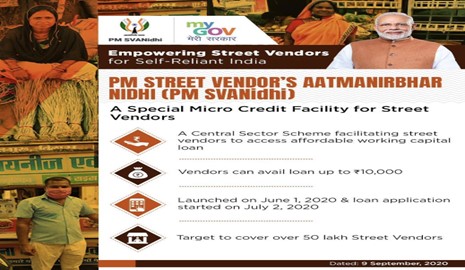- Courses
- GS Full Course 1 Year
- GS Full Course 2 Year
- GS Full Course 3 Year
- GS Full Course Till Selection
- Answer Alpha: Mains 2025 Mentorship
- MEP (Mains Enrichment Programme) Data, Facts
- Essay Target – 150+ Marks
- Online Program
- GS Recorded Course
- Polity
- Geography
- Economy
- Ancient, Medieval and Art & Culture AMAC
- Modern India, Post Independence & World History
- Environment
- Governance
- Science & Technology
- International Relations and Internal Security
- Disaster Management
- Ethics
- NCERT Current Affairs
- Indian Society and Social Issue
- NCERT- Science and Technology
- NCERT - Geography
- NCERT - Ancient History
- NCERT- World History
- NCERT Modern History
- CSAT
- 5 LAYERED ARJUNA Mentorship
- Public Administration Optional
- ABOUT US
- OUR TOPPERS
- TEST SERIES
- FREE STUDY MATERIAL
- VIDEOS
- CONTACT US
PM SVANidhi scheme
PM SVANidhi scheme
25-10-2023

Context
Recently, SBI analysed the PM SVANidhi scheme's impact on street vendors.
Background
- The Modi government's microcredit PM SVANidhi plan for street sellers has been commended by an SBI research paper for promoting inclusive entrepreneurship.
- According to recent sources, 44% of OBC recipients of the PM SVANidhi plan are from the non-general category, making up 75% of the scheme's beneficiaries.
- According to the research, women make up 43% of the overall beneficiaries of PM Street Vendor's AtmaNirbhar Nidhi (PM SVANidhi) initiative, with Scheduled Castes and Scheduled Tribes accounting for 22% of all disbursements.
- SVANidhi has been tagged as a gender equalizer by the SBI research, which stated that the female share implies empowerment of entrepreneurial capacities of urban girls.
About PM SVANidhi scheme
- PM SVANidhi scheme Launched in 2020.
- Ministry: Ministry of Housing & Urban Affairs.
- Implementation agency: Small Industries Development Bank of India (SIDBI).
- Objective: Enabling vendors on the streets who have suffered because of the COVID-19 lockdown to resume their livelihoods by offering them reasonable Working Capital loans.
- The scheme aims to provide working capital loans to about 50 lakh street vendors with no collateral needed and a one-year term of up to INR 10,000.
- It is a Central Sector Scheme.
- Central sector schemes: programs carried out by the Central Government apparatus and fully financed by the Central Government.
- Duration of the scheme: Originally, the scheme was to run until March 2022.
Extension of the scheme
- It is now valid till December 2024.
- This was carried out with an emphasis on the comprehensive socio-economic development of the street vendors and their families, heightened use of digital transactions, and improved collateral-free, affordable loan corpus.
- A third loan with a maximum amount of ₹50,000 was added to the first and second loans, which had limits of ₹10,000 and ₹20,000, respectively.
Features of the scheme
- Loan limit: Up to Rs. 10,000 in working capital loans are available to vendors.
- For a period of one-year, monthly installments are required to be paid back on this loan.
- Because there is no collateral needed to apply for the loan, street sellers can get it more easily.
- Processing fee: Street vendors can apply for the scheme at no cost because there is no processing fee.
- Loan repayment period: one year.
- Interest subsidy: an interest subsidy at the rate of 7% annually upon timely or early loan return.
- Through Direct Benefit Transfers, it will be credited to beneficiaries' bank accounts on a quarterly basis.
- Early repayment: No penalty on early repayment of the loan.
- Additional benefits: The vendors can avail of the facility of escalation of the credit limit on timely/ early repayment of a loan.
- Credit limit: the maximum amount of credit a financial institution extends to a client on a credit card or a line of credit.
Target beneficiaries under the scheme
- Street vendors are the intended beneficiaries of this scheme.
- Any person involved in selling items, goods, wares, or food items on a street, footpath, or pavement, or while moving from one location to another is referred to as a vendor in the scheme's standards.
- Goods supplied: fruits, vegetables, ready-to-eat street food, tea, pakodas, apparel, artisan products, books/ stationary etc.
- Services provided: cobblers, barber shops, pan shops, laundry services etc.
Advantages of the scheme
- The scheme encourages online purchases by offering cash-back incentives up to Rs. 100 each month.
- The scheme promotes entrepreneurship.
- Additionally, it promotes employment opportunities. (PM SVANidhi's Socio-Economic Profiling Program started).
Must Check: Best IAS Coaching In Delhi



